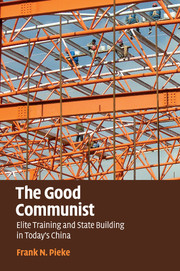Book contents
- Frontmatter
- Contents
- List of illustrations
- Preface
- Map 1 The People's Republic of China
- Map 2 Yunnan Province
- 1 Socialism, capitalism and the anthropology of neo-socialist rule
- 2 Cadres, cadre training and party schools
- 3 Cadre training and education in the twenty-first century
- 4 Life and work at party schools
- 5 Marketization and centralization of cadre education and training
- 6 Cadre training, cadre careers and the changing composition of China's political elite
- 7 Conclusions: cadre training and the future of party rule
- Appendix 1 List of interviewees
- Appendix 2 Student questionnaire survey
- Appendix 3 Glossary of Chinese terms
- References
- Index
Appendix 2 - Student questionnaire survey
Published online by Cambridge University Press: 29 March 2010
- Frontmatter
- Contents
- List of illustrations
- Preface
- Map 1 The People's Republic of China
- Map 2 Yunnan Province
- 1 Socialism, capitalism and the anthropology of neo-socialist rule
- 2 Cadres, cadre training and party schools
- 3 Cadre training and education in the twenty-first century
- 4 Life and work at party schools
- 5 Marketization and centralization of cadre education and training
- 6 Cadre training, cadre careers and the changing composition of China's political elite
- 7 Conclusions: cadre training and the future of party rule
- Appendix 1 List of interviewees
- Appendix 2 Student questionnaire survey
- Appendix 3 Glossary of Chinese terms
- References
- Index
Summary
The survey was carried out between September and December 2005 among all cadres who participated in a training programme at the Yunnan Provincial Party School. The questionnaire was designed together with Professor Duan Eryu of the party school, and administered by the class teachers (ban zhuren) at the school. The survey results were coded in MS Excel and analysed in SPSS. A full list of survey variables is attached at the end of this appendix.
A total of 490 questionnaires were distributed with 362, or 74%, valid returns. Three-quarters (74%) of the respondents were men and one-quarter (26%) were women. Around two-thirds of the participants were between the ages of 40 and 49 (65%). The age distribution for men and women was similar, with modal ages of 43 for men and 44 for women. There were seven ranks in the study population: below ke, vice ke, full ke, vice chu, full chu, vice ting and full ting. The largest category of respondents were of ke rank (171, or 47%), followed by chu (133, or 37%), and the highest rank ting (19, or 5%). The largest individual rank in the study was vice chu (93), followed by full ke (83); together they constitute 49% of respondents.
- Type
- Chapter
- Information
- The Good CommunistElite Training and State Building in Today's China, pp. 201 - 205Publisher: Cambridge University PressPrint publication year: 2009

